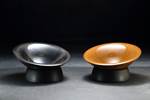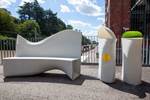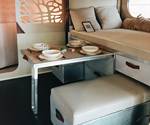Hyfer Objects furniture incorporates Sulapac wood composites
High-end design furniture is 3D printed from bio-based, eco-friendly materials for aesthetic and sustainable home product options.
Ebacken lounge chair made with Sulapac materials. Source | Hyfer Objects
’s (Helskinki, Finland) bio-based, eco-friendly wood composites materials are now being incorporated into ’ (previously Ekbacken Studios, Stockholm, Sweden) entire signature Collection no.1 of environmentally conscious “masterpiece” furniture. The continued partnership with 3D technology company, The Industry (Malmö, Finland) ensures that the trio are merging technology and sustainability to produce high-end furniture locally.
The incorporation of Sulapac’s materials indicate Hyfer’s committment against environmental degradation while producing high-end design pieces. Made of biodegradable biopolymers and natural wood, Sulapac leaves no permanent microplastics or toxic residues behind. The wood originates from industrial side streams, and in the future, will also use recycled biopolymers. Moreover, the materials have a low carbon footprint compared to conventional plastic.
Learn more about Supalac materials, “Sulapac introduces Sulapac Flow 1.7 to replace PLA, ABS and PP in FDM, FGF”
Hyfer Objects is dedicated to creativity, quality and environmental responsibility. It aims to continue its focus on using a variation of circular materials to create luxurious design pieces.
“It’s inspiring to see how seamlessly Sulapac material and Hyfer’s contemporary designs play together,” Juho Luukkanen, sales director at Sulapac, says. “It’s a pleasure to work with another Nordic forerunner willing to challenge the status quo while fostering a culture of excellence.”
Besides 3D printing, the Sulapac portfolio includes materials for injection molding, extrusion and thermoforming.
Related Content
-
JEC World 2024 highlights: Glass fiber recycling, biocomposites and more
CW technical editor Hannah Mason discusses trends seen at this year’s JEC World trade show, including sustainability-focused technologies and commitments, the Paris Olympics amongst other topics.
-
Biomaterials make strides toward composites sustainability
A compilation of trends in development or application of natural fibers, bio-based resins and more showcases industry players, educational institutes and global projects.
-
Airbus works to improve the life cycle of composites in future aircraft
This companion article to CW's September 2024 Airbus Illescas plant tour discusses recycling, LCA, biocomposites, Fast Track technologies, qualification and more.






